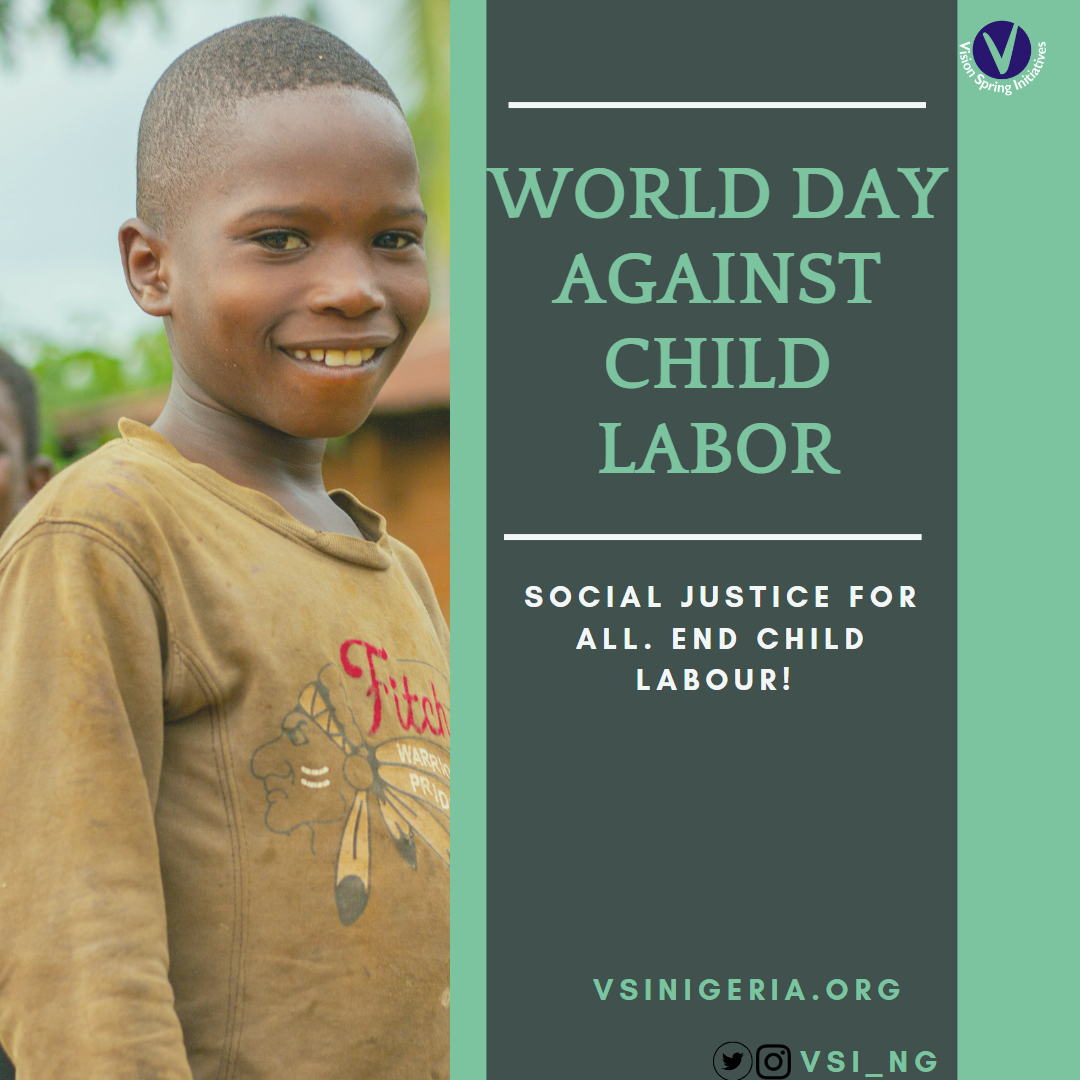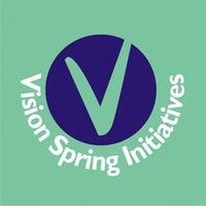CHILD LABOUR DAY
In commemoration of World Day against Child Labour Vision Spring Initiatives celebrate every Nigerian child and every child around the globe. We advocate that every child deserves to have a healthy environment at home and in the society at large. Allowing the child to experience the normal stages of life without interference helps the child be a healthy individual. We believe every child’s life matter.
Vision Spring Initiatives (VSI), a youth-focused organization works in partnership with children, adolescents, and other relevant agencies to advance their rights to health and protection from all forms of violence by strengthening their capacities, engaging relevant agencies, and influencing policies for improved quality of life. The organization is established on the premise that women and girls have a significant role to play in national development when given opportunities.
WHO IS A CHILD?
A child is a young human below the age of puberty or below the age of 18 according to the Nigerian constitution.
Chapter IV (Section 33 – 46) of the 1999 Constitution of the Federal Republic of Nigeria (FRN) provides for the fundamental rights of every person including children.
These rights include:
- The Right to Life (Section 33)
- The Right to Dignity of the human person (Section 34)
- The Right to personal liberty (Section 35)
- The Right to fair-hearing (Section 36)
- The Right to privacy and family life (Section 37)
- The Right to freedom of thought, conscience, and religion (Section 38)
- The Right to freedom of expression and the press (Section 39)
- The Right of freedom of movement (Section 40)
- The Right to freedom from discrimination (Section 41)
- The Right to acquire and own immovable property anywhere in Nigeria (Section 42)
- The Right against compulsory acquisition of one’s property without compensation (Section 43)
WHAT IS LABOUR?
Labour means hard work, physical work, exertion, or making a great effort on something.

WHAT IS CHILD LABOUR?
Child labour means the engagement of children in any work that prevents the child/wards the state of being a child or enjoying childhood. Thereby, hindering the ability of the child to attend a well-organized school, and that is morally, mentally, physically, or socially dangerous and harmful. Which is regarded as illegal by many international organizations. Legislation across the world restrains child labour. These laws do not consider all work by children as child labour; exceptions include work by child artists, family duties, supervised training, and others.
ORIGIN OF CHILD LABOUR IN NIGERIA
- Poverty: The high rate of poverty is one of the major genesis of child labour in Nigeria
- Inadequate family planning: The estimated 200 million people living in Nigeria are below the poverty line. This, in turn, is making lots of children below the age of 18 go into child labour to support their families.
- One-parent family (i.e. broken homes): Children from Broken homes are continuously exposed to financial constraints due to one person bearing the financial burden of the family or because the father of the child/children is irresponsible. Therefore, most children from such homes tend to go into child labour such as; hawking, building site labourer, agricultural farm labourer, and others. Just to support their family and reduce the financial constraints on the available parent.
- Polygamy: This is the tradition of marrying more than one wife in Africa. Children from polygamous home suffer financial constraints which in turn deprives them of basic education.
BRIEF HISTORY OF CHILD LABOUR
Child Labour could possibly be traced to the mid-1980s as a result of the adverse condition in Nigeria’s economy. Driven by economic, social, and demographic factors such as poverty and loss of employment of parents, loss of a parent or family guardian, rural-urban migration, large family size, and cultural norms like maldistribution of school, poor accessibility, and high cost of tuition. Recently conflicts and terrorism have caused internal displacements of people and bring destruction to school facilities, making more children go into child labour children between the aged 5-14. Taking into note the mass killings of communities by bandits in Northern Nigeria have contributed to creating more orphans and potential victims of child labour.
In Nigeria, no fewer than 15 million children are engaged in child labour. The Nigeria Employers Consultative Association (NECA) listed communities in Niger, Ondo and Osun State as some of the communities where child labour is prevalent in Nigeria.
TYPES OF CHILD LABOUR
- Compromises children education
- Child sexual exploitation
- Agricultural labour
- Restricting their rights and limiting their future opportunities which leads to vicious inter-generational cycles of poverty and child labour.
To reverse the upward trend in child labour, the international labour organization and UNICEF are calling for:
- Adequate sexual protection for all; including universal child benefits
- Increased spending on quality education and getting all children back into school including children who are were out of school before COVID-19.
- Promotion of decent work for adult, so families don’t have to resort to children helping to generate family income.
- An end to harmful gender norms and discrimination that influence child labour.
- Investment in child protection systems, agricultural development, rural public service, infrastructure and livelihood.
DANGER OF CHILD LABOUR
- Emotional abuse ( such as constant criticism and using negative words on a child)
- Sexual abuse (such as rape or someone trying to touch or play with a child’s private part).
- Physical risks include hitting, poisoning, burning, drowning, suffocating, or otherwise causing physical harm to a child.
- Health problems caused by working in hazardous conditions
Nigeria Child Rights Act prohibits the following:
a) use of children for the purpose of begging for alms, guiding beggars, prostitution, domestic or sexual labor or for any unlawful or immoral purpose;
b) Use of children as a slave or for practices similar to slavery such as the sale or trafficking of the child, debt bondage or serfdom, and forced or compulsory labour;
c) Use of children for hawking of goods or services on main city streets, brothels, or highways;
d) Use of children for any purpose that deprives the child of the opportunity to attend and remain in school as provided for under the Compulsory, Free Universal Basic Education Act;
e) Procurement or offer for prostitution or for the production of pornography or for any pornographic performance; and
f) Procurement or offering for any activity in the production or trafficking of illegal drugs and any other activity relating to illicit drugs as specified in the National Drug Law Enforcement Agency Act.
Violation of this provision is punishable with imprisonment for a term of ten years.
STATISTICS OF OUT OF SCHOOL CHILDREN PER STATE IN NIGERIA.
- Bauchi – 1,239,759
- Katsina – 873,633
- Jigawa – 784,391
- Kano – 837,479
- Kaduna – 652,990
- Gombe – 567,852
- Adamawa – 484,702
- Kebbi – 484,702
- Zamfara – 383,952
- Benue – 383,022
- Oyo – 463,280
- Niger – 478,412
- Sokoto – 462,164
- Yobe – 405,100
- Sokoto – 462,164
- Taraba – 338,975
- Borno – 266,178
- Osun – 260,222
- Plateau – 258,256
- Lagos – 229,256
- Nasarawa – 204,771
- Cross River – 140,944
- Kwara – 141,325
- Ebonyi – 151,000
- Ogun – 158,797
- Kogi – 169,316
So, therefore, we strongly urge the government, individuals, and society as a whole to actively contribute to creating a safe and secure environment for our children. It is crucial that we collectively work towards putting an end to all forms of violence against children and prioritize the well-being of our future generations. By taking immediate and decisive action, we can build a community that fosters the safety, protection, and healthy development of our children. To achieve this, it is imperative for the government to enact and enforce stringent laws and policies that safeguard children’s rights and hold perpetrators of violence accountable. Additionally, investing in comprehensive education and awareness programs will help raise public consciousness about child protection and empower individuals to take a stand against violence.
Furthermore, individuals have a crucial role to play in creating a safe environment for children. Each one of us should be vigilant and responsive to signs of abuse or mistreatment, reporting any concerns to the appropriate authorities. By actively promoting positive parenting practices and nurturing respectful and compassionate relationships with children, we can contribute to their overall well-being and prevent the occurrence of violence. Society at large also bears the responsibility of creating a culture that rejects violence against children. By fostering a supportive and inclusive community, we can create spaces where children feel safe to speak up about their experiences and seek help. Community organizations, religious institutions, schools, and other social institutions should collaborate to provide comprehensive support systems for children and families, ensuring their access to counseling, legal assistance, and other necessary resources.
In conclusion, by joining hands and working together, we can build a society that cherishes and protects the rights of children. Let us unite in our commitment to eradicating violence against children, creating a nurturing environment where they can thrive and grow into responsible and resilient individuals. Our collective efforts today will shape a brighter and safer future for generations to come.
REFERENCE
- https//www.child.labour.org/world-child-labour-laws/nigerias-child-labour-law 02 May 2023
- UN Agenda 2030 – Sustainable Development Goals:
https://sustainabledevelopment.un.org/?menu=1300 - AU Agenda 2063 – the Africa we want:
https//www.un.org/en/Africa/osaa/pdf/au/agenda2063-framework.pdf - Daily trust report on child sexual abuse and abortion:
https://www.dailytrust.com.ng/doctor-guardian-remanded-over-abortion-for-14-yr-old-girl.html.january 2020 - Source: §59(5-8) & 60 of the Labour Act (Cap L1 LFN 2004); §28-30 of the Child’s Rights Act, 2003
